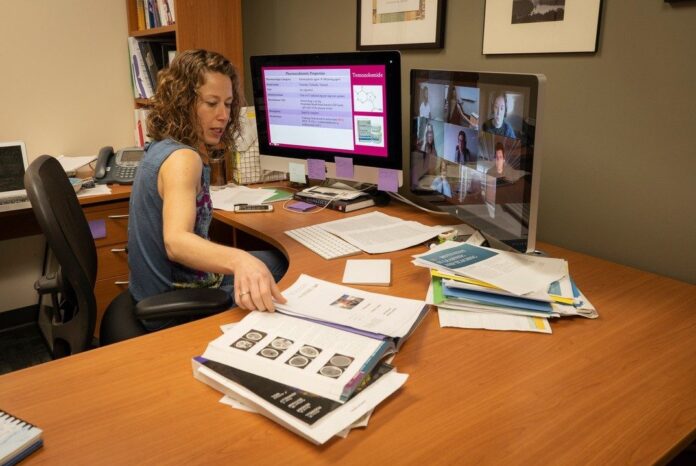As Virginia Tech took measures to help stop the spread of COVID-19, instruction moved online. For the Virginia Tech Carilion School of Medicine, that meant moving some types of high-interaction curriculum into new formats, including one of the signature components of the medical school’s unique curriculum – its small-group, problem-based learning method.
Known as PBL to the students and faculty members, the method is used in the first and second years of the curriculum as a way for students to learn the basic science they need to know as physicians within the frame work of real patient cases. Instead of sitting through lectures to learn the science, students work in small groups of seven to eight students. A faculty facilitator is in each group as a guide, but, for the most part, the students teach each other.
“With concerns about COVID-19, our faculty had only a few days to figure out how to transition the highly interactive curricular component online,” said Lee Learman, dean of the Virginia Tech Carilion School of Medicine. “Our faculty worked quickly to move it into a virtual space, while striving to preserve the special features of PBL.”
Faculty set up separate Zoom rooms for each small group. They meet three times a week for a few hours in each small group. Then, the entire class joins a Zoom together at the end of the week to meet the physician who worked on the case they studied that week. If a patient is able to join virtually, they can be added to the Zoom meeting as well.
“What I’m most surprised about over the PBL experience in the virtual environment is that the interactions remained very organic and very positive between the facilitator and the peers and the peers themselves,” said Renee LeClair, chair of the Department of Basic Science Education.
“I was initially nervous about having to move to an online platform so quickly without much time for training. But with Dr. LeClair’s ‘we can do this’ attitude and the help the IT team, it’s gone much more smoothly than I had anticipated,” said Joanne Greenawald, director of the problem-based learning curriculum. “I think the online PBL platform is meeting our educational objectives, and it’s great to still have some connection with the students during this very disconnected time.”
So far, student feedback has indicated that the transition has gone as well as it can, given the circumstances.
“Personally, I have always used PBL to synthesize what we’ve been learning in basic science and clinical science and combine those to help me better understand and better learn the material,” said Rebekah Sayre, a first-year medical student. “When I found out we were transitioning, I was nervous that it wouldn’t be the same and I wouldn’t have the same opportunities for learning. However, PBL has been one of our most successful transitions as far as staying true to what I would expect to see in an in-person PBL session.”
Some challenges have included occasional issues with internet connectivity for students or faculty. Some students returned to their family to quarantine, leading to some being in different time zones for their virtual meetings. It is also more difficult to share some content, like writing on a white board in a physical space, but faculty and students are getting creative to overcome the challenges.
“I’m realizing now how much of my teaching depends on knowing where the students are from nuanced body language, whether they’re getting frustrated, who needs help and who doesn’t,” said Andrew Binks, associate professor and director of professional development in the Department of Basic Science Education. “All of that is much more difficult on online, but it’s something that I’m going to learn as we use this environment.”
There have been some perks to the new virtual format. “It is humanizing the experience of being separated at this moment,” LeClair said. “We’re seeing everybody’s cats and children interact and pop on the screen and making this environment as positive and cozy as possible.”
“There are unlimited opportunities for coffee and snacks and anything that you would need to make yourself comfortable to facilitate your learning is really at the tips of your fingertips, which is quite nice,” noted Sayre.
For the near future, the virtual delivery of PBL and the rest of the curriculum will continue to help stop the spread of COVID-19 and keep faculty, students, and the community safe.
“The opportunity to stay connected is so important,” said Jennifer Cleveland, assistant professor of basic science education. “Virtual learning is providing continuity for both students and faculty during this time physically away from our campus.”
LeClair notes that faculty facilitators are keeping notes what works well in virtual PBL to see if some aspects can be woven into the school’s in-person PBL program when operations return to normal.

